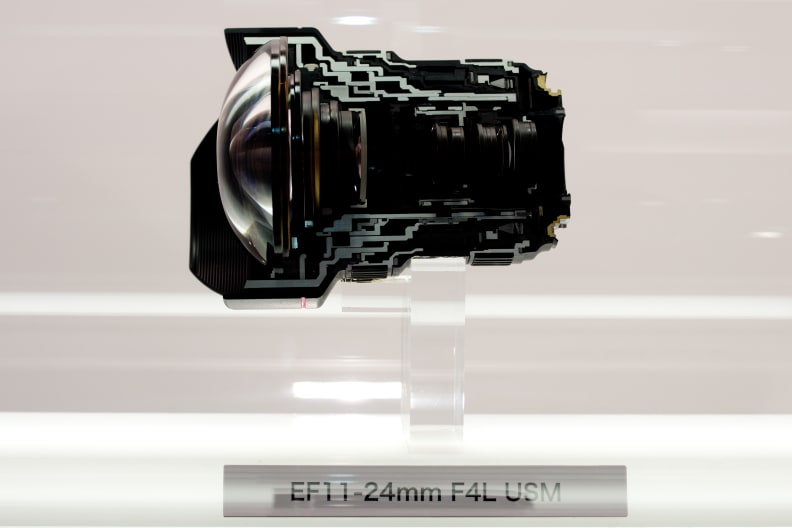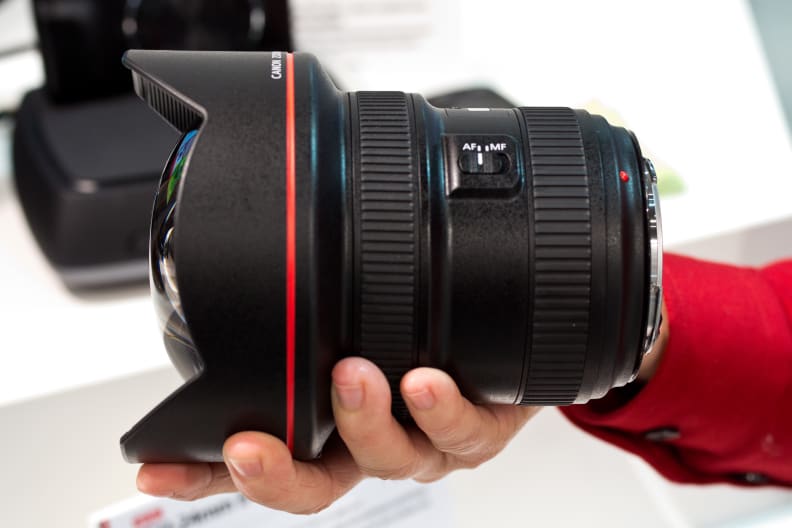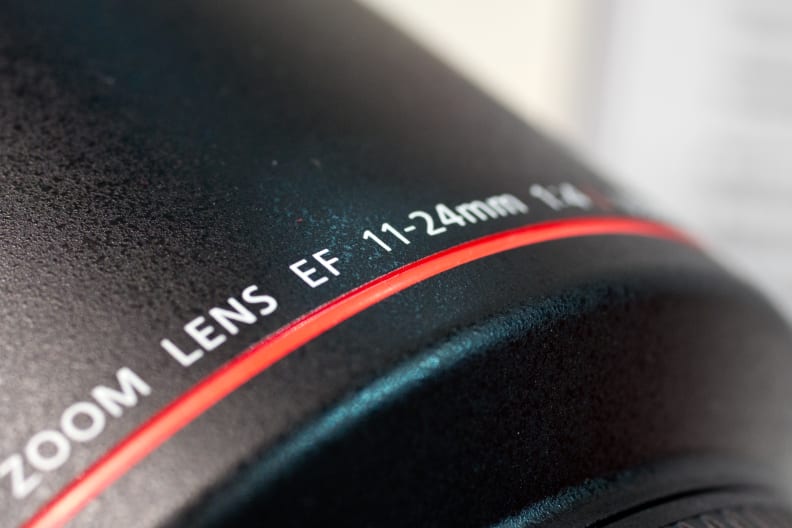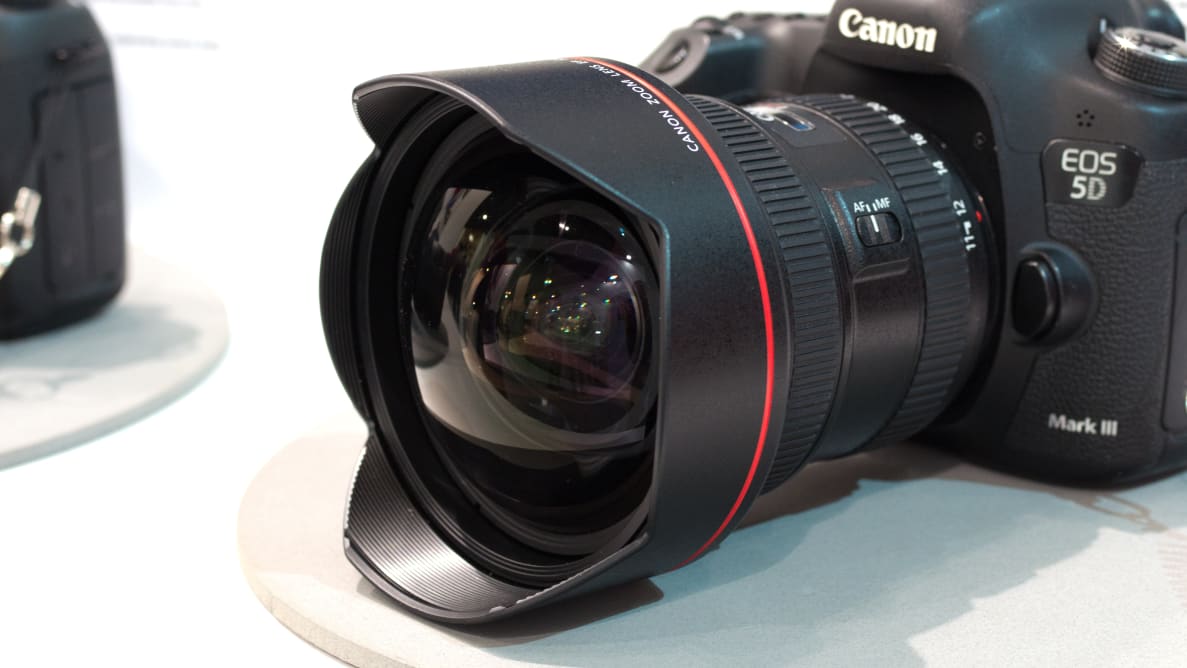The brand new EF 11–24mm f/4L USM is an excellent case in point: It's the widest rectilinear zoom lens in the world, which means it should be a constant companion for architectural and landscape photographers everywhere. It promises optical quality unlike any other ultra-wide zoom on the market, with the size, weight, and price to match.
Last week, we had the chance to go hands-on with this optical monster at CP+ 2015 in Yokohama, Japan. Here's what we found.
Look & Feel
A pro-quality lens, with the build quality to match
The first thing you'll notice about the 11–24mm f/4L is its crushing, back-breaking weight.
I'm only half kidding. At 1,180 grams (about 2.6lbs) it's actually heavier than Canon's 7D Mark II, 5D Mark III, and 5DS. In fact, the only current Canon cameras that are heavier are the pro EOS-1D IV and 1D X. Needless to say, this is a lens that will unbalance all but the heaviest EOS DSLRs. Canon was displaying one that had been cut in half at CP+, and it was absolutely packed to the gills with glass and electronics.

When viewed in all its glory, the internals of the 11-24mm f/4L are extremely impressive.
In total, the 11–24mm f/4L has 16 elements in 11 groups, including four aspherical elements, one Super UD low dispersion element, one regular UD element, and fluorine coating on both the front and rear elements for durability and resistance to the elements. It also has a built-in petal hood and a slot behind behind the rear element for slide-in filters.

The 11-24mm handles as well as you'd expect from an L-series lens, with a smoothly operating focus ring.
If you prefer to focus manually, you'll probably be a little disappointed in the focusing ring. It's on the narrow side, with fairly loose (though very smooth) rotation. That said, the focus throw is long for an autofocus lens, which means it's easy to make fine adjustments. Like many modern AF lenses, it lacks hard stops, but there's a slight click on either end of the focus range and a focus scale that indicates when you've gone as far as you can go.
But most of the time you're going to be using autofocus, and there's plenty of good news there. In our time shooting with the lens on the show floor, the USM focusing motor was quick, quiet, and reliably accurate. There's an AF/MF switch on the side of the lens for quick switching, and the close focusing distance of 11 inches should help make it an extremely flexible tool. The zoom ring, meanwhile, turns very smoothly and has the light-but-accurate feel that should translate to superb usability in the field.
But as impressive as this lens is to hold (and behold), it really begins to show its worth once you mount it on a camera.
Through the Finder
Architectural photographers, eat your heart out.
Canon had multiple copies of the 11–24mm f/4L available to try out at CP+, mounted to all manner of full-frame bodies. We used it with both a new Canon 5DS R and the larger EOS-1D X, and it complemented both beautifully. When viewed through their large viewfinders the lens provides a beautifully, surprisingly expansive view that sucks in the surrounding environment like a black hole.
The official specs peg its angle of view at 126.05° on the wide end, shrinking to "just" 84° at 24mm. But what sets it apart from other ultra-wide-angle zoom lenses is that it's also rectilinear, so the straight and parallel lines in your scene remain straight and parallel in your shots. It's an incredibly difficult feat to pull off, as evidenced by how few ultra-wide rectilinear zooms exist, even in this age of computer-assisted design.

The 11-24mm f/4L is massive, easily dwarfing this poor woman's hand.
It's also incredibly important to both landscape and architectural photographers. Until now, they've either had to opt for less flexible primes like the EF 14mm f/2.8L, or third-party zooms like Sigma's 12–24mm f/4.5-5.6 DG HSM II. However, it's worth noting that while the new 11–24mm is almost entirely free of barrel distortion, it's no replacement for a tilt-shift lens like Canon's superb 17mm f/4L TS-E, which can correct for perspective distortion created by shooting subjects above or below the camera.
Instead, this is designed to be a more flexible complement to those sorts of lenses. It'll work equally well for real estate shots, unusual close-up portraits, and shooting inside of a stadium at a football game.
Conclusion
Impressive, but priced beyond reason for anyone but pros
The Canon EF 11–24mm f/4L USM has a lot going for it. It's one of very few ultra-wide-angle rectilinear zooms, and its main competition is the Sigma 12–24mm f/4.5-5.6 DG HSM II, which is rectilinear but isn't as wide, isn't weather-sealed, and doesn't have a constant maximum aperture.

The 11-24mm f/4L lens is bound to be an aspirational buy for Canon landscape and architectural photographers.
What the Sigma does have on its side is price. It costs well under $1,000 at retail, and can be had used for under $600. The Canon 11–24mm, meanwhile, will ring the till at the wallet-scarring price of $2,999. That makes it the most expensive wide-angle zoom lens in Canon's portfolio, and one of its most expensive optics overall. The only lenses more expensive are all super-telephoto sports lenses.
But for the right photographer (read: working pros) that won't matter too much. Three thousand dollars isn't cheap, but it's not beyond the means of professional landscape and architecture photographers, or the publications and companies that back them. The Sigma is a great option for enthusiasts, but for photographers who absolutely have to get the shot, this Canon stands alone.
Meet the tester
TJ is the former Director of Content Development at Reviewed. He is a Massachusetts native and has covered electronics, cameras, TVs, smartphones, parenting, and more for Reviewed. He is from the self-styled "Cranberry Capitol of the World," which is, in fact, a real thing.
Checking our work.
Our team is here for one purpose: to help you buy the best stuff and love what you own. Our writers, editors, and lab technicians obsess over the products we cover to make sure you're confident and satisfied. Have a different opinion about something we recommend? Email us and we'll compare notes.
Shoot us an email


